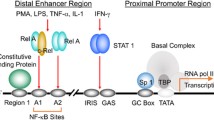Summary
Ascitic fluid from women with advanced ovarian carcinomas was shown to contain factor(s) which inhibit(s) T lymphocyte mitogenesis. The factor(s) was (were) demonstrated to be associated with the infiltrating macrophages. The inhibition was reversible and inhibited mitogenesis at some late event in the cell cycle. The inhibitory substance(s) was (were) noncytotoxic, dialyzable, heat-stable at 70° C for 10 min (but unstable at 100° C for 15 min), and partially resistant to protease treatment (55%–70%). Further experiments demonstrated that macrophages isolated from the ascitic fluid of patients with cirrhosis of the liver also released factor(s) which inhibit(s) T lymphocyte mitogenesis. On the basis of our data and data from other investigators, we propose that in advanced human ovarian cancer of epithelial origin, macrophages which infiltrate the ascitic fluid elaborate nonspecific inhibitors of T lymphocyte blastogenesis within the proximal environment, resulting in localized immunosuppression and the subsequent enhancement of metastasis within the peritoneal cavity, the tumor cells themselves being resistant to the cytocidal action of the macrophages due to genetic selection and/or their inherent biochemical ability to circumvent normal immunosurveillance mechanisms. This may account, at least in part, for the rapid metastasis and poor prognosis of human ovarian adenocarcinomas.
Similar content being viewed by others
References
Ablin RJ (1977) Immunobiology of the prostate. In: Tannebaum M (ed) Urologic pathology — The prostate; Vol 1. Lea and Febiger, Philadelphia, pp 33–58
Badger AM, Cooperband SR, Merluzzi VJ, Glasgow AH (1977) Immunosuppressive activity of ascitic fluid from patients with cancer metastatic to the peritoneum. Cancer Res 37:1200
Bormer OP (1976) Purification of a cytotoxic factor from human and rat tissues. Br J Cancer 34:359
Boyum A (1954) Separation of white blood cells. Nature 204:793
Carr I (1977) Macrophages in human cancer. A review. In: James K, McBride B, Stuart A (eds) The macrophage and cancer. University Press, Edinburgh, pp 364–374
Eccles SA, Alexander P (1974) Macrophage content of tumors in relation to metastatic spread and host immune reaction. Nature 250:667
Eilber FR, Merton DL (1970) Impaired immunological reactivity and recurrence following cancer surgery. Cancer 25:362
Evans R (1976) Tumor macrophages in host immunity to malignancies. In: Find MA (ed) The macrophage in neoplasia: Academic Press, New York, pp 27–42
Friedman H, Ceglowski WS (1976) Immunologic aspects of neoplasia. In: Beers W (ed) MD Anderson Symposium. Baltimore, pp 253–291
Gardner RJ, Preston FW (1962) Prolonged skin homograft survival in advanced cancer and cirrhosis of the liver. Surg Gynecol Obstet 115:394
Harris J, Bagai RC (1972) Immune deficiency states associated with malignant disease in man. Med Clin North Am 56:501
Gorelik F, Wittrout RH, Brunda MJ, Holden HT, Heberman RB (1982) Augmentation of metastasis formation by thioglycollate-elicited macrophages. Int J Cancer 29:575
Heberman RB (1976) Immunologic approaches to the diagnosis of cancer. Cancer 37:549
Hersch EM, Drewinko B (1974) Specific inhibition of lymphocyte blastogenic responses to mutagens by a factor produced by cultured human malignant lymphoma cells. Cancer Res 34:215
Hess AD, Gall SA, Dawson JR (1979) Inhibition of in vitro lymphocyte function by cystic and ascitic fluids from ovarian cancer patients. Cancer Res 39:2381
Hess AD, Gall SA, Dawson JR (1980) Partial purification and characterization of a lymphocyte-inhibiting factor(s) in ascitic fluids from ovarian cancer patients. Cancer Res 40:1842
Hewlit G, Opitz H, G Schlumberger HG, Lemke L (1977) Growth regulation of a murine lymphoma line by a 2-mercaptoethanol or macrophage-activated serum factor. Eur J Immunol 7:781
Kamo I, Friedman H (1977) Characterization of a dialyzable immunosuppressive fraction from mastocytoma culture supernatants. Proc Soc Exp Biol Med 156:177
Kersey JH, Specter BD, Good RA (1973) Immunodeficiency and cancer. Adv Cancer Res 18:211
Lowry OH, Rosebrough NJ, Farr AL, Randall RJ (1951) Protein measurement with the folin phenol reagent. J Biol Chem 193:265
Mantovani A (1981) In vitro effects on tumor cells of macrophages isolated from early passage chemically-induced murine sarcoma and from its spontaneous metastasis. Int J Cancer 27:221
Mantovani A, Polentarutti N, Peri G, Shavit ZB, Vecchi A, Bolis G, Mangioni C (1980) Cytotoxicity on tumor cells of peripheral blood monocytes and tumor-associated macrophages in patients ovarian tumors. INCI 64:1307
Mantovani A, Gaivazzi R, Allessandri G, Spreafico F, Garattini S (1981) Characterization of tumor lines derived from spontaneous metastasis of a transplanted murine sarcoma. Eur J Cancer 17:71
Miller DC (1968) The immunologic capability of patients with lymphoma. Cancer Res 28:1441
Moore K, Moore M (1977) Intra-tumor host cells of transplanted rat neoplasms of different immunogenicity. Int J Cancer 19:1803
Namba Y, Hanooka M (1972) Immunocytology of cultured IgM-forming cells of mouse. 1. Requirement of phagocytic cell factor for the growth of IgM-forming cells in tissue culture. J Immunol 109:1193
Nathan CF, Terry WD (1975) Differential stimulation of murine lymphoma growth in vitro in normal and BCG-activated macrophages. J Exp Med 142:887
Peri G, Polentarutti N, Sessa C, Mangioni C, Mantovani A (1981) Tumoricidal activity of macrophages isolated from human ascitic and solid ovarian carcinomas: augmentation by interferon, lymphokines and endotoxin. Int J Cancer 28:143
Prat M, Tarone G, Comoglio PM (1981) Mouse fibroblasts transformed by Rous sarcoma virus express a virus-specific non-virion transplantation antigen. Int J Cancer 27:797
Remacle-Bonnet MM, Pommier GJ, Kaplanski S, Range RJ, Depieds RC (1976) Inhibition of normal allogenic lymphocyte mitogenesis by a soluble inhibition factor from human colonic cacinoma. J Immunol 117:1145
Renck CM, Gupta RK, Morton DL (1981) Inhibition of normal allogenic mitogenesis by a factor released from human tumors in culture. Cancer Immunol Immunother 11:7
Salmon SE, Hamburger AW (1978) Immunoproliferation and cancer; a common macrophage-derived promoter substance. Lancet I:1289
Ting CC, Tsai SC, Rogers MJ (1977) Host control of tumor growth. Science 197:571
Author information
Authors and Affiliations
Rights and permissions
About this article
Cite this article
Sheid, B., Boyce, J. Inhibition of lymphocyte mitogenesis by factor(s) released from macrophages isolated from ascitic fluid of advanced ovarian cancer patients. Cancer Immunol Immunother 17, 190–194 (1984). https://doi.org/10.1007/BF00205484
Received:
Accepted:
Issue Date:
DOI: https://doi.org/10.1007/BF00205484




